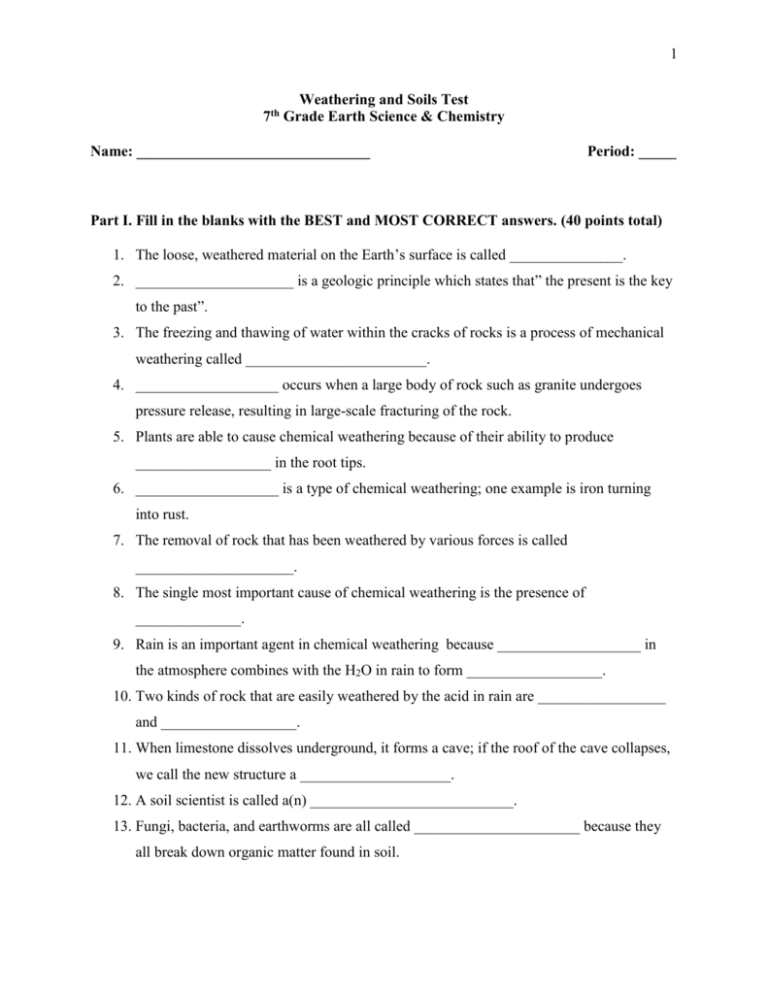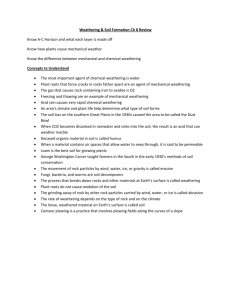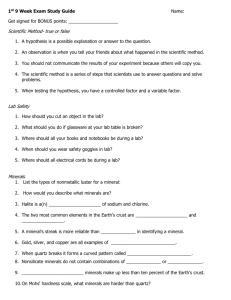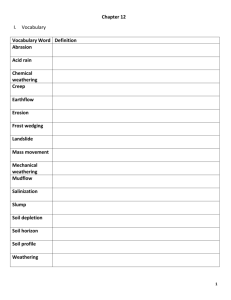Weathering and Soils Test
advertisement

1 7th Weathering and Soils Test Grade Earth Science & Chemistry Name: _______________________________ Period: _____ Part I. Fill in the blanks with the BEST and MOST CORRECT answers. (40 points total) 1. The loose, weathered material on the Earth’s surface is called _______________. 2. _____________________ is a geologic principle which states that” the present is the key to the past”. 3. The freezing and thawing of water within the cracks of rocks is a process of mechanical weathering called ________________________. 4. ___________________ occurs when a large body of rock such as granite undergoes pressure release, resulting in large-scale fracturing of the rock. 5. Plants are able to cause chemical weathering because of their ability to produce __________________ in the root tips. 6. ___________________ is a type of chemical weathering; one example is iron turning into rust. 7. The removal of rock that has been weathered by various forces is called _____________________. 8. The single most important cause of chemical weathering is the presence of ______________. 9. Rain is an important agent in chemical weathering because ___________________ in the atmosphere combines with the H2O in rain to form __________________. 10. Two kinds of rock that are easily weathered by the acid in rain are _________________ and __________________. 11. When limestone dissolves underground, it forms a cave; if the roof of the cave collapses, we call the new structure a ____________________. 12. A soil scientist is called a(n) ___________________________. 13. Fungi, bacteria, and earthworms are all called ______________________ because they all break down organic matter found in soil. 2 14. The process by which organisms mix the soil by burrowing is called _____________________. 15. The ideal soil type is called _________________. It is composed of ___________________ of sand, silt, and clay. 16. The ___________________________ is the maximum angle that sediment of a given grain size and texture can be piled to before slope failure occurs. 17. The larger the grain size, the _____________________ the angle. 18. Name one factor other than size and shape that affects the angle that a pile can attain: ________________________________________________ 19. Laterite soils are important to mankind because they are a source of the mineral _____________. 20. Pedalfers, typical of the eastern U.S., are found in ____________ climates; pedocals, on the other hand, are typical of the _____________ climates found in the western U.S. Part II. Short Answer. 1. Describe the relationship between the size of particles in a rock and: (1) porosity; (2) permeability and (3) capillary water (water retained). (10 points) 3 2. List the 5 major factors in soil formation and state briefly (in one or two sentences) why or how that factor affects soil type. (10 points) 3. A gardener digs up the soil while planting a garden in the spring, and she picks out every earthworm she finds and throws it in the trash. Is the gardener helping or hurting her chances for a healthy garden? Explain your answer. (10 points) 4 4. Which would weather faster, exposed limestone in southern Florida or exposed granite in northern Canada? Explain your reasoning. Include in your answer a description of what types of weathering each type of rock might experience. (10 points) 5. List the 3 most important nutrients for plants and state at least one reason why plants need that nutrient. (10 points) 5 6. Use the diagram to answer the following questions. (10 points) a. In which layer of soil in the diagram would you find humus? What is the soil in this layer called (or what name do we give to this layer)? b. Which layer of soil in the diagram is made up of only partly weathered rock and no humus at all? 6 c. Which layer in the diagram provides the basic material that forms soil? What do we call this layer? d. Which layer of soil in the diagram contains clay and minerals, but only a little humus? (Hint: it is called the zone accumulation). What is the name given to this layer? e. What is litter and where can you find it in the diagram?








